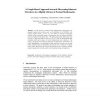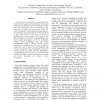1082 search results - page 195 / 217 » Learning the Semantic Meaning of a Concept from the Web |
IAT
2008
IEEE
14 years 2 months ago
2008
IEEE
Collaborative tagging systems have emerged in recent years to become popular tools for organising information on the Web. While collaborative tagging offers many advantages, they ...
MKM
2004
Springer
14 years 1 months ago
2004
Springer
As the amount of online formal mathematical content grows, for example through active efforts such as the Mathweb [21], MOWGLI [4], Formal Digital Library, or FDL [1], and others, ...
CI
2006
13 years 8 months ago
2006
We present two methods for determining the sentiment expressed by a movie review. The semantic orientation of a review can be positive, negative, or neutral. We examine the effect...
DAGSTUHL
2007
13 years 9 months ago
2007
Local tag structures have become frequent through Web 2.0: Users "tag" their data without specifying the underlying semantics. Every user annotates items in an individual...
IEEESCC
2006
IEEE
14 years 2 months ago
2006
IEEE
End-user service composition is a promising way to ensure flexible, quick and personalized information provision and utilization, and consequently to better cope with spontaneous ...


